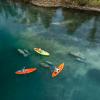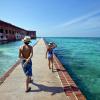Generations ago, throughout Florida, Native Americans built shell mounds. Here's where you can see them today.
By Lisa M. Moten
These curious Native American sites are scattered around the Sunshine State. In the modern era, many of these shell mounds in Florida were looted for road building, but today the cherished relics are understood to be more than just slag heaps of mastodon teeth and bone. Some are pyramid-shaped and many were ceremonial. While most of the stories and rituals have been lost to time there is enough left to allow us to step back 1,000 years.
Indian Temple Mound Museum
Fort Walton Beach
139 Miracle Strip Parkway Southeast, 850-833-9595
fwb.org/347/Indian-Temple-Mound-Museum
Situated beside one of the largest ceremonial mounds in Florida, this museum boasts one of the nation’s largest and finest collection of ceramic artifacts. With roughly 1,000 artifacts and extensive exhibits, the Indian Temple Mound Museum provides visitors an inside look at the lifestyles of four southeastern American Indian groups that inhabited the Choctawhatchee Bay region for the last 12,000 years. Temple Mound also offers tours a research library and a museum shop. Open six days a week throughout the year, with extended operating hours during the summer.
Hontoon Island
DeLand
2309 River Ridge Road, 386-736-5309
floridastateparks.org/park/Hontoon-Island
Hontoon Island is surrounded by water – a combination of the St. Johns River, Hontoon Dead River, and Snake Creek – and is accessible only by private boat or park ferry. Native Americans were the first on record to inhabit this island. Snails gathered from the river were a staple food of the tribes. Discarded shells accumulated over time to form these large mounds that still exist. Today visitors will find picnic areas, boating, camping, canoeing, and fishing. Check out the visitor center to learn more about the animals found on the island and history of the area.
Randell Research Center
Pineland
13810 Waterfront Drive, 239-283-2157
flmnh.ufl.edu/rrc
The Randell Research Center is dedicated to teaching visitors about the culture, history, and environment of Southwest Florida and its earliest inhabitants -- the Calusa Indian tribe. Located on the western shore of Pine Island, the center sits on more than 50 acres at the heart of the archaeological site – an enormous Calusa shell mound that extends across more than 200 acres from the coastline. While there, tour the Calusa Heritage Trail, a 3,700-foot path that leads visitors through mounds and canals. Guided tours are available January to April.
Historic Spanish Point
Osprey
33 N. Tamiami Trail, 941-966-5214
historicspanishpoint.org
Historic Spanish Point, one of Florida’s premier archaeological spots, is a 30-acre historical and environmental site that extends into the waters of Little Sarasota Bay. With its pioneer buildings, the restored gardens of Mrs. Potter Palmer, and prehistoric burial and ceremonial mounds, Historic Spanish Point offers visitors the chance to rediscover 5,000 years of history. Enjoy the large Butterfly Garden and nature trails or take a 90-minuted guided tour of the site. Don’t miss the “A Window to the Past” archaeology exhibition located inside the shell mound.
Indian Mound Park
Englewood
210 Winson Ave., 941-861-5000
scgov.net/parks/Pages/IndianMoundPark.aspx
Indian Mound Park is a 10-acre public park and historic site of the Calusa Indian tribe. Indian mounds on site, along with a collection of artifacts dating back to 400 B.C., add rich historical value to the recreation there. The surrounding park is home to nature trails, picnic areas, a public boat ramp, and parking. Open 365 days a year. Free.
Shell Mound
Cedar Key
16450 NW 31st Place, 352-493-0238
www.friendsofrefuges.org/shell-mound-trail.html
Six miles outside Cedar Key on the Gulf Coast stands Shell Mound of Cedar Key, part of the Lower Suwannee National Wildlife Refuge. Shell Mound is the largest prehistoric shell midden on the central Gulf Coast, covering five acres and rising 28 feet above sea level. Near the water, people lived and ate from the Gulf for 6,000 years dating back to 2,500 B.C. It is believed to be the location of special gatherings for Native American groups across the broader region. Excavations by archaeologists from the University of Florida have discovered the remains of large feasts that took place in the summer – likely celebrating the Summer Solstice, the longest day of the year. This massive kitchen midden was built from discarded oyster, clam, and whelk shells. Today, visitors will also find nature and hiking trails, choice kayaking, bird watching, bank fishing, and spectacular coastal views.
Lake Jackson Mounds
Tallahassee
3600 Indian Mounds Road, 850-922-6007
floridastateparks.org/lakejackson/default.cfm
Throughout Florida, paleo-Indian tribes made hundreds of mounds for ceremonial and practical purposes. Lake Jackson Mounds State Archaeological Site, one of North Florida’s premier archaeological sites, was built between 1200 and 1500 A.D. The site served as the political and religious center for Native American cultures in the area just north of Tallahassee. The site consists of six earth temple mounds; the tallest of which stands higher than 35 feet. Visitors often hike to the top of it for a magnificent view of the entire site. Open daily.
Crystal River Indian Mounds
Crystal River
3400 N. Museum Point, 352-795-3817
floridastateparks.org/park/Crystal-River-Archaeological
Considered one of the longest continually occupied sites in the state, this Florida mound is believed to have been occupied for more than 1600 years. Florida’s first inhabitants traveled long distances to Crystal River for ritual burials and to trade goods and services. Built by pre-Columbian Indians, the Crystal River Archaeological State Park contains burial mounds, temple/platform mounds, and a midden. A paved loop trail passes by each mound with interpretive signs detailing each one’s history. The site, designated a U.S. National Historic Landmark in 1990, was used for ceremonial purposes and the visitor center houses tools jewelry and pottery recovered from the site.
Spruce Creek Indian Shell Mound
Port Orange
1755 Martin’s Dairy Road, 386-736-5953
crackercreek.com
One of the Timucua Indians’ larger habitations was in the Spruce Creek basin, as evidenced by the wealth of archaeological sites and resources there. Among the known resources are some of the largest and most extensive prehistoric shell mounds in the nation, many so high they were used as major navigational landmarks during early colonial times. One of the largest prehistoric earthen works in Florida, the Spruce Creek Mound is located on a high bluff. The site functioned as a major ceremonial and political center for the Timucuans and lesser mounds are scattered throughout the surrounding areas.
Mound House
Fort Myers Beach
451 Connecticut St, Fort Myers Beach, FL 33931, 239-765-0865
moundhouse.org
This beautifully landscaped property on Estero Bay, owned by the Town of Fort Myers Beach, includes the oldest standing structure on Estero Island — the William H. Case House — complete with the furnishings and finishes that it would have had in its heyday of 1921. The house serves as a multi-level museum, showcasing Calusa artifacts and interactive exhibits. The Ancient People exhibit displays tools and weapons that were excavated on site, as well as recreated replicas that allow you to get hands-on experience. You can then explore the Settlers on the Shells exhibit, which shows life on Estero Island after the Calusa, highlighting the settler’s fishing culture. Even the bathrooms feature an exhibit, entitled Digging Deeper, that displays interactive photos and ancient crafts within the walls.























